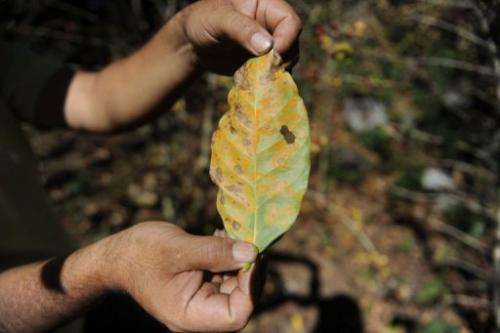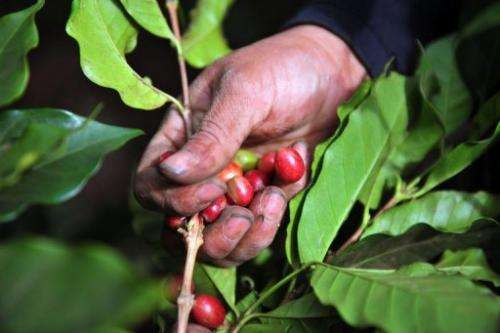A man shows a leaf of coffee plant affected by Roya at San Victor farm in Los Verdes village, Fraijanes municipality, 35 km of Guatemala City on January 17, 2013. Central America is scrambling to contain a coffee-eating fungus that has invaded a third of the impoverished region's crops, threatening to cost the vital industry hundreds of millions of dollars.
Central America is scrambling to contain a coffee-eating fungus that has invaded a third of the impoverished region's crops, threatening to cost the vital industry hundreds of millions of dollars.
Entire families depend on work from the coffee-growing industry in Central America, which employs more than 1.5 million people to produce one of the world's most renowned Arabica beans.
But in September, two months before the annual harvest, the fungus known as roya began to spread due to a lack of preventive measures and the effects of climate change, including high temperatures and drought, according to experts, government officials and industry sources.
"The situation is very serious," Jose Buitrago, president of Nicaragua's Coffee Exporters Association, told AFP. "It will get worse if measures are not taken."
The fungus, hemileia vastatrix, discolors and dries up coffee leaves, an effect that also gives roya the name of "leaf rust."
The parasite has latched on to 35 percent of the 958,000 hectares of sown crops, which will mean a loss of two million coffee bean bags of 46 kilograms (100 pounds) each, industry officials told AFP.
This would represent a loss of $300 million at the current price of $150 per bag, the sources said.
Central American nations exported 17.5 million bags of coffee during the 2011-2012 cycle, bringing $3.6 billion to the region, and growers had hoped to do even better this season. The harvest begins in November and ends in February.
A worker collects coffee beans at a farm in Cuatro Esquinas, on the outskirts of Diriamba some 32 km south from Managua, on January 17, 2013. Governments and producers will try to contain the invasion by pruning infected leaves, putting up effective shading systems and planting fungus-resistant seeds to replace dead coffee plants, said Nicaraguan Agriculture Minister Ariel Bucardo.
"The entire coffee region is affected, some more than others," Marcelino Samayo, director general of El Salvador's coffee exporters' association.
Central America's coffee plantations are held by more than 300,000 producers, and the majority are small- and medium-sized growers with few means to control the outbreak.
Governments and producers will try to contain the invasion by pruning infected leaves, putting up effective shading systems and planting fungus-resistant seeds to replace dead coffee plants, said Nicaraguan Agriculture Minister Ariel Bucardo.
The Salvadoran Coffee Research Foundation recommended fertilizing the soil and cutting off all leaves covered in roya, which cannot survive in dead leaves.
The Regional International Organization for Plant Protection and Animal Health (OIRSA) will back the measures, but the region, which lacks resources, also plans to seek foreign loans.
Guatemala needs $843 million in investments to renew its coffee plantations while Nicaragua is looking at $200 million, according to preliminary industry figures.
While roya is plaguing the whole region, Honduras and Nicaragua stand to lose the most as coffee is their main export. It represents $1.4 billion, or 22 percent, of exports for Honduras and $519 million, or 18 percent, for Nicaragua.
In Honduras, considered Central America's coffee king, the fungus has devastated 10 percent of 280,000 hectares of crops, according to the head of the Honduran Coffee Institute, Victor Molina.
The fungus has hit 30 percent of Nicaragua's 128,000 hectares of coffee, prompting the government and the industry to seek funds to help 35,000 growers.
Guatemala's National Coffee Association warned that roya has reached 67 percent of its 274,000 hectares, threatening to leave 200,000 people without work.
El Salvador could be forced to destroy 30 percent of its 161,000 hectares of coffee, while Costa Rica declared a sanitary emergency after the parasite invaded 30 percent of its 93,000 hectares.
"Producers let their guard down. Costa Rica could lose more than 250,000 (coffee bags)," said Costa Rican Deputy Agriculture Minister Xinia Chaves.
Roya has also infected 30 percent of Panama's 22,000 hectares of coffee plants.
(c) 2013 AFP
























